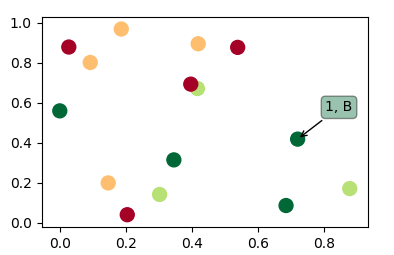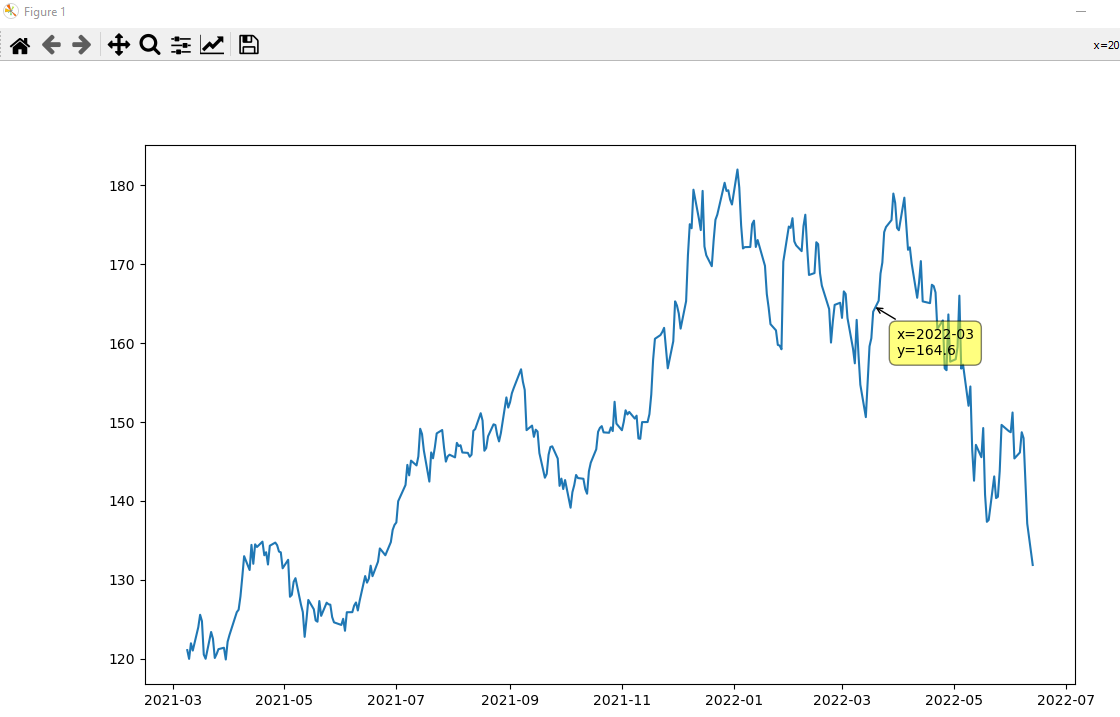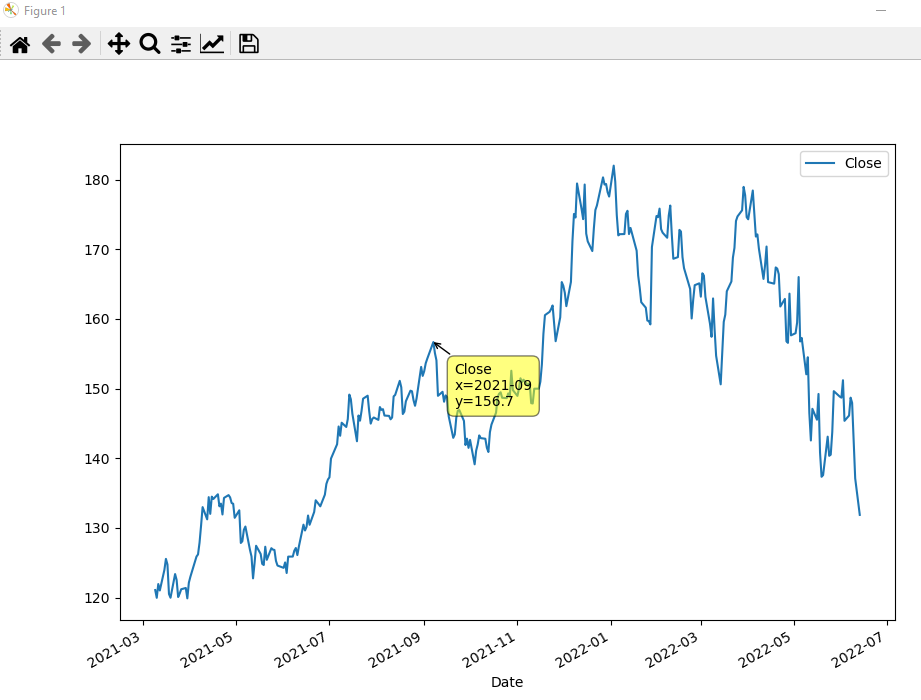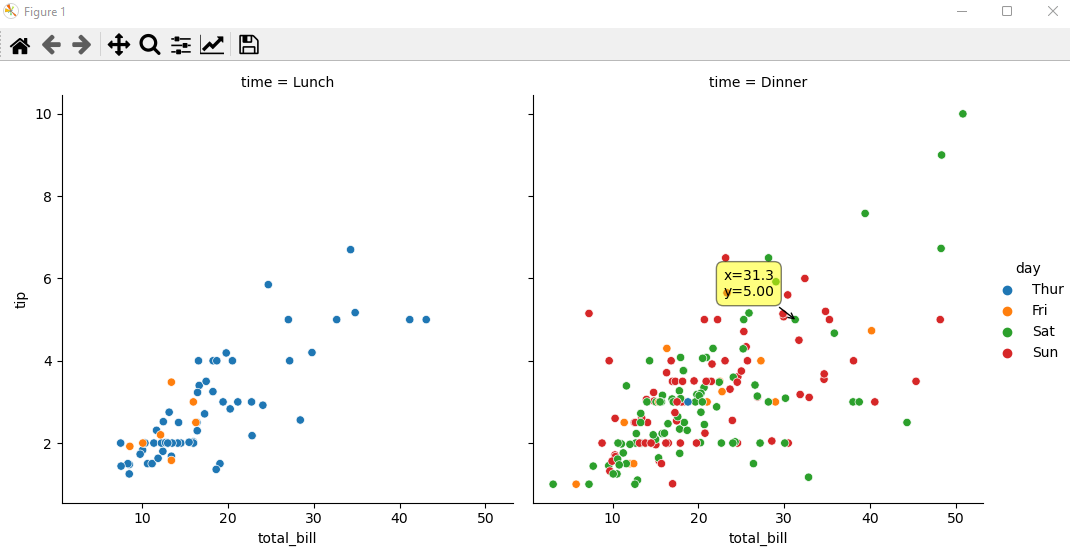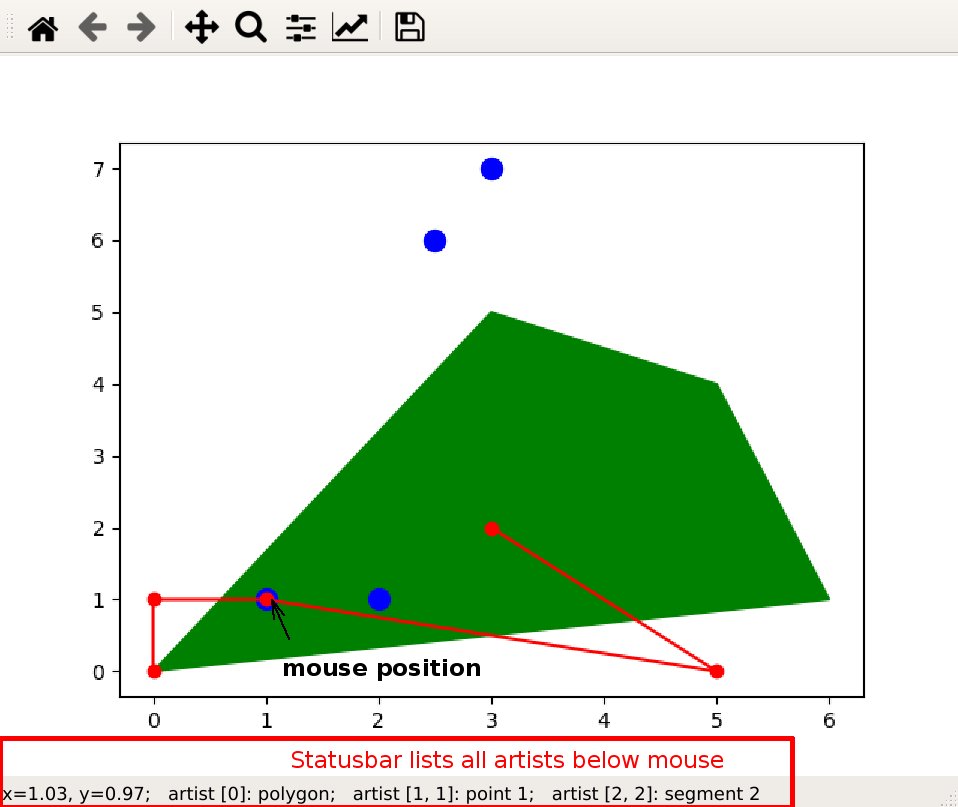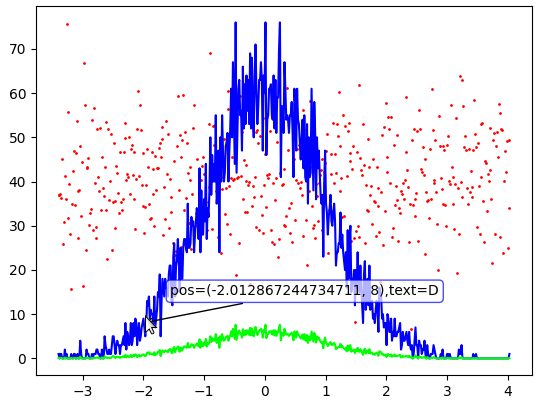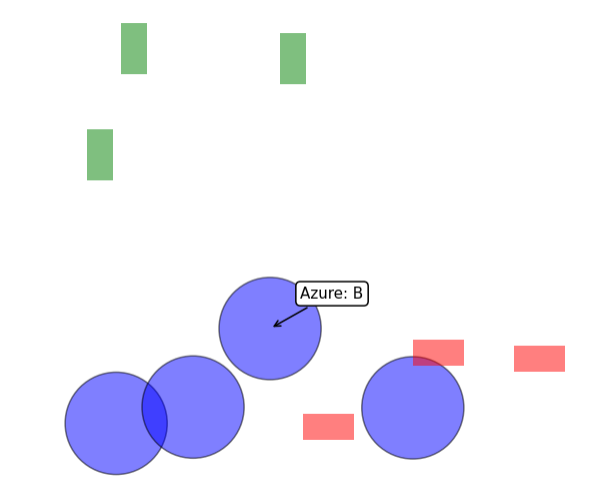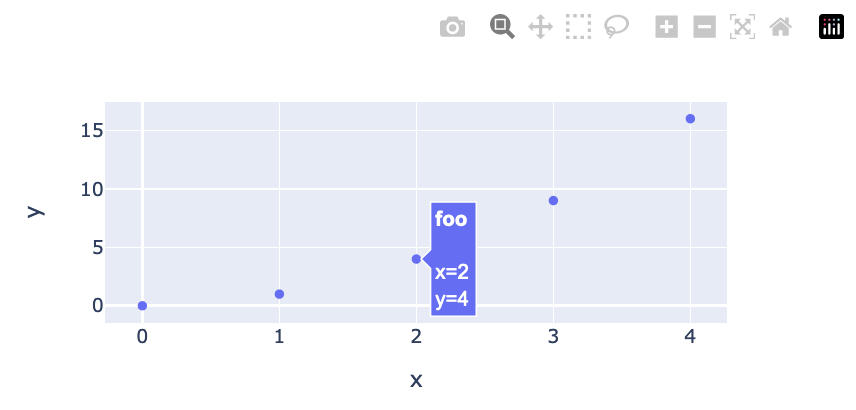I am using matplotlib to make scatter plots. Each point on the scatter plot is associated with a named object. I would like to be able to see the name of an object when I hover my cursor over the point on the scatter plot associated with that object. In particular, it would be nice to be able to quickly see the names of the points that are outliers. The closest thing I have been able to find while searching here is the annotate command, but that appears to create a fixed label on the plot. Unfortunately, with the number of points that I have, the scatter plot would be unreadable if I labeled each point. Does anyone know of a way to create labels that only appear when the cursor hovers in the vicinity of that point?
Here is a code that uses a scatter and shows an annotation upon hovering over the scatter points.
import matplotlib.pyplot as plt
import numpy as np; np.random.seed(1)
x = np.random.rand(15)
y = np.random.rand(15)
names = np.array(list("ABCDEFGHIJKLMNO"))
c = np.random.randint(1,5,size=15)
norm = plt.Normalize(1,4)
cmap = plt.cm.RdYlGn
fig,ax = plt.subplots()
sc = plt.scatter(x,y,c=c, s=100, cmap=cmap, norm=norm)
annot = ax.annotate("", xy=(0,0), xytext=(20,20),textcoords="offset points",
bbox=dict(boxstyle="round", fc="w"),
arrowprops=dict(arrowstyle="->"))
annot.set_visible(False)
def update_annot(ind):
pos = sc.get_offsets()[ind["ind"][0]]
annot.xy = pos
text = "{}, {}".format(" ".join(list(map(str,ind["ind"]))),
" ".join([names[n] for n in ind["ind"]]))
annot.set_text(text)
annot.get_bbox_patch().set_facecolor(cmap(norm(c[ind["ind"][0]])))
annot.get_bbox_patch().set_alpha(0.4)
def hover(event):
vis = annot.get_visible()
if event.inaxes == ax:
cont, ind = sc.contains(event)
if cont:
update_annot(ind)
annot.set_visible(True)
fig.canvas.draw_idle()
else:
if vis:
annot.set_visible(False)
fig.canvas.draw_idle()
fig.canvas.mpl_connect("motion_notify_event", hover)
plt.show()
Because people also want to use this solution for a line plot instead of a scatter, the following would be the same solution for plot (which works slightly differently).
import matplotlib.pyplot as plt
import numpy as np; np.random.seed(1)
x = np.sort(np.random.rand(15))
y = np.sort(np.random.rand(15))
names = np.array(list("ABCDEFGHIJKLMNO"))
norm = plt.Normalize(1,4)
cmap = plt.cm.RdYlGn
fig,ax = plt.subplots()
line, = plt.plot(x,y, marker="o")
annot = ax.annotate("", xy=(0,0), xytext=(-20,20),textcoords="offset points",
bbox=dict(boxstyle="round", fc="w"),
arrowprops=dict(arrowstyle="->"))
annot.set_visible(False)
def update_annot(ind):
x,y = line.get_data()
annot.xy = (x[ind["ind"][0]], y[ind["ind"][0]])
text = "{}, {}".format(" ".join(list(map(str,ind["ind"]))),
" ".join([names[n] for n in ind["ind"]]))
annot.set_text(text)
annot.get_bbox_patch().set_alpha(0.4)
def hover(event):
vis = annot.get_visible()
if event.inaxes == ax:
cont, ind = line.contains(event)
if cont:
update_annot(ind)
annot.set_visible(True)
fig.canvas.draw_idle()
else:
if vis:
annot.set_visible(False)
fig.canvas.draw_idle()
fig.canvas.mpl_connect("motion_notify_event", hover)
plt.show()In case someone is looking for a solution for lines in twin axes, refer to How to make labels appear when hovering over a point in multiple axis?
In case someone is looking for a solution for bar plots, please refer to e.g. this answer.
ind["ind"] is actually a list of indexes for all points under the curser. This means that the above code actually gives you access to all points at a given position, and not just the top most point. For instance, if you have two overlapping points the text could read 1 2, B C or even 1 2 3, B C D if you had 3 overlapping points. –
Joyejoyful 0 8, A I, (see picture). –
Neopythagoreanism fig.canvas.draw_idle() many times (it even changes the cursor to idle). I solved it storing the previous index and checking if ind["ind"][0] == prev_ind. Then only update if you move from one point to another (update text), stop hovering (make the annotation invisible) or start hovering (make annotation visible). With this change it's way more clean and efficient. –
Karyolysis .contains at all. You just take the information from the bar itself. –
Neopythagoreanism bar-like graphs returns a container of artist objects, the code above cannot be straightforwardly duplicated. For the record, one can find here an example of an bar graph, annotated in the middle of each bar upon hovering. –
Westerfield %matplotlib notebook in an IPython/Jupyter notebook. –
Neopythagoreanism annot.set_ha, annot.set_va and modified xytext, but they are not aligned properly when redrawn. The box is aligned to the xy coordinates (end of the arrow) instead of the start of the arrow. I end up with the box and the arrow on the correct quadrant but they are one on top of the other, the box hides the arrow. Any idea why? –
Pair annot.set_hat and annot.xytext but the result is the same. However, if I call ax.annotate with the same parameters, the arrow and text are aligned properly. –
Pair cont, ind = heat.contains(event) returns True,None. How do I get it to return valid indexes? –
Afterword annot.set_wrap(True) into this solution if your labels run off the edge of the plot. –
Krohn xs, ys, zs = sc._offsets3d; vxs, vys, vzs = proj_transform(xs, ys, zs, ax.get_proj()); sorted_z_indices = np.argsort(vzs)[::-1]; annot.set_text(names[sorted_z_indices[ind['ind'][0]]]) –
Politick This solution works when hovering a line without the need to click it:
import matplotlib.pyplot as plt
# Need to create as global variable so our callback(on_plot_hover) can access
fig = plt.figure()
plot = fig.add_subplot(111)
# create some curves
for i in range(4):
# Giving unique ids to each data member
plot.plot(
[i*1,i*2,i*3,i*4],
gid=i)
def on_plot_hover(event):
# Iterating over each data member plotted
for curve in plot.get_lines():
# Searching which data member corresponds to current mouse position
if curve.contains(event)[0]:
print("over %s" % curve.get_gid())
fig.canvas.mpl_connect('motion_notify_event', on_plot_hover)
plt.show()
matplotlib...) - does this work with ipython/jupyter notebooks? Does it also work when there are multiple subplots? What about on a bar-chart rather than a line-graph? –
Woodwaxen plot.get_lines() also gives the points not only the lines, if you have plotted the the points using plot.plot(). –
Drunken - Using the
mplcursorspackage is probably the easiest option.- mplcursors: read the docs
- mplcursors: github
- If using Anaconda, install with these instructions, otherwise use these instructions for
pip.
- This must be plotted in an interactive window, not inline.
- For jupyter, executing something like
%matplotlib qtin a cell will turn on interactive plotting. See How can I open the interactive matplotlib window in IPython notebook?
- For jupyter, executing something like
- Tested in
python 3.10,pandas 1.4.2,matplotlib 3.5.1,seaborn 0.11.2
import matplotlib.pyplot as plt
import pandas_datareader as web # only for test data; must be installed with conda or pip
from mplcursors import cursor # separate package must be installed
# reproducible sample data as a pandas dataframe
df = web.DataReader('aapl', data_source='yahoo', start='2021-03-09', end='2022-06-13')
plt.figure(figsize=(12, 7))
plt.plot(df.index, df.Close)
cursor(hover=True)
plt.show()
Pandas
ax = df.plot(y='Close', figsize=(10, 7))
cursor(hover=True)
plt.show()
Seaborn
- Works with axes-level plots like
sns.lineplot, and figure-level plots likesns.relplot.
import seaborn as sns
# load sample data
tips = sns.load_dataset('tips')
sns.relplot(data=tips, x="total_bill", y="tip", hue="day", col="time")
cursor(hover=True)
plt.show()
From http://matplotlib.sourceforge.net/examples/event_handling/pick_event_demo.html :
from matplotlib.pyplot import figure, show
import numpy as npy
from numpy.random import rand
if 1: # picking on a scatter plot (matplotlib.collections.RegularPolyCollection)
x, y, c, s = rand(4, 100)
def onpick3(event):
ind = event.ind
print('onpick3 scatter:', ind, npy.take(x, ind), npy.take(y, ind))
fig = figure()
ax1 = fig.add_subplot(111)
col = ax1.scatter(x, y, 100*s, c, picker=True)
#fig.savefig('pscoll.eps')
fig.canvas.mpl_connect('pick_event', onpick3)
show()
- This recipe draws an annotation on picking a data point: http://scipy-cookbook.readthedocs.io/items/Matplotlib_Interactive_Plotting.html .
- This recipe draws a tooltip, but it requires wxPython: Point and line tooltips in matplotlib?
print statement should also use parens for compatibility with python 3 –
Curvature A slight edit on an example provided in http://matplotlib.org/users/shell.html:
import numpy as np
import matplotlib.pyplot as plt
fig = plt.figure()
ax = fig.add_subplot(111)
ax.set_title('click on points')
line, = ax.plot(np.random.rand(100), '-', picker=5) # 5 points tolerance
def onpick(event):
thisline = event.artist
xdata = thisline.get_xdata()
ydata = thisline.get_ydata()
ind = event.ind
print('onpick points:', *zip(xdata[ind], ydata[ind]))
fig.canvas.mpl_connect('pick_event', onpick)
plt.show()
This plots a straight line plot, as Sohaib was asking
The other answers did not address my need for properly showing tooltips in a recent version of Jupyter inline matplotlib figure. This one works though:
import matplotlib.pyplot as plt
import numpy as np
import mplcursors
np.random.seed(42)
fig, ax = plt.subplots()
ax.scatter(*np.random.random((2, 26)))
ax.set_title("Mouse over a point")
crs = mplcursors.cursor(ax,hover=True)
crs.connect("add", lambda sel: sel.annotation.set_text(
'Point {},{}'.format(sel.target[0], sel.target[1])))
plt.show()
Leading to something like the following picture when going over a point with mouse:
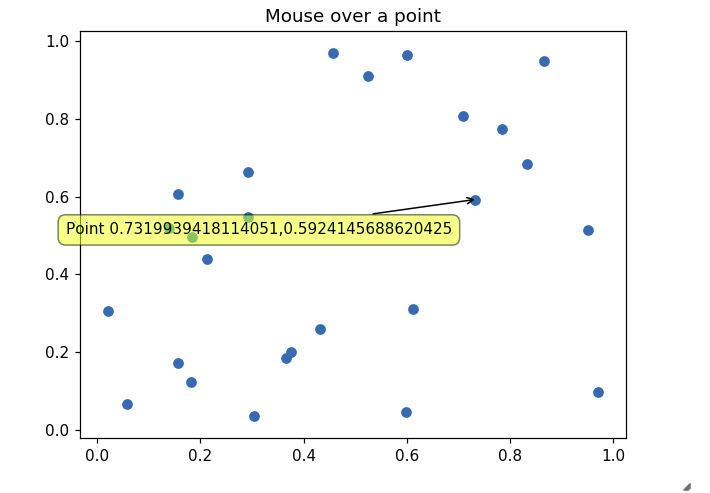
mpld3 solves it for me.
import matplotlib.pyplot as plt
import numpy as np
import mpld3
fig, ax = plt.subplots(subplot_kw=dict(axisbg='#EEEEEE'))
N = 100
scatter = ax.scatter(np.random.normal(size=N),
np.random.normal(size=N),
c=np.random.random(size=N),
s=1000 * np.random.random(size=N),
alpha=0.3,
cmap=plt.cm.jet)
ax.grid(color='white', linestyle='solid')
ax.set_title("Scatter Plot (with tooltips!)", size=20)
labels = ['point {0}'.format(i + 1) for i in range(N)]
tooltip = mpld3.plugins.PointLabelTooltip(scatter, labels=labels)
mpld3.plugins.connect(fig, tooltip)
mpld3.show()
You can check this example: https://mpld3.github.io/examples/scatter_tooltip.html
TypeError: array([1.]) is not JSON serializable. –
Plata mplcursors worked for me. mplcursors provides clickable annotation for matplotlib. It is heavily inspired from mpldatacursor (https://github.com/joferkington/mpldatacursor), with a much simplified API
import matplotlib.pyplot as plt
import numpy as np
import mplcursors
data = np.outer(range(10), range(1, 5))
fig, ax = plt.subplots()
lines = ax.plot(data)
ax.set_title("Click somewhere on a line.\nRight-click to deselect.\n"
"Annotations can be dragged.")
mplcursors.cursor(lines) # or just mplcursors.cursor()
plt.show()
matplotlib makes every 10th line the same colour, such a pain. mplcursors sorts it out though. –
Sacaton I have made a multi-line annotation system to add to: https://mcmap.net/q/115955/-how-to-add-hovering-annotations-to-a-plot. for the most up to date version: https://github.com/AidenBurgess/MultiAnnotationLineGraph
Simply change the data in the bottom section.
import matplotlib.pyplot as plt
def update_annot(ind, line, annot, ydata):
x, y = line.get_data()
annot.xy = (x[ind["ind"][0]], y[ind["ind"][0]])
# Get x and y values, then format them to be displayed
x_values = " ".join(list(map(str, ind["ind"])))
y_values = " ".join(str(ydata[n]) for n in ind["ind"])
text = "{}, {}".format(x_values, y_values)
annot.set_text(text)
annot.get_bbox_patch().set_alpha(0.4)
def hover(event, line_info):
line, annot, ydata = line_info
vis = annot.get_visible()
if event.inaxes == ax:
# Draw annotations if cursor in right position
cont, ind = line.contains(event)
if cont:
update_annot(ind, line, annot, ydata)
annot.set_visible(True)
fig.canvas.draw_idle()
else:
# Don't draw annotations
if vis:
annot.set_visible(False)
fig.canvas.draw_idle()
def plot_line(x, y):
line, = plt.plot(x, y, marker="o")
# Annotation style may be changed here
annot = ax.annotate("", xy=(0, 0), xytext=(-20, 20), textcoords="offset points",
bbox=dict(boxstyle="round", fc="w"),
arrowprops=dict(arrowstyle="->"))
annot.set_visible(False)
line_info = [line, annot, y]
fig.canvas.mpl_connect("motion_notify_event",
lambda event: hover(event, line_info))
# Your data values to plot
x1 = range(21)
y1 = range(0, 21)
x2 = range(21)
y2 = range(0, 42, 2)
# Plot line graphs
fig, ax = plt.subplots()
plot_line(x1, y1)
plot_line(x2, y2)
plt.show()
showing object information in matplotlib statusbar
Features
- no extra libraries needed
- clean plot
- no overlap of labels and artists
- supports multi artist labeling
- can handle artists from different plotting calls (like
scatter,plot,add_patch) - code in library style
Code
### imports
import matplotlib as mpl
import matplotlib.pylab as plt
import numpy as np
# https://mcmap.net/q/115955/-how-to-add-hovering-annotations-to-a-plot
# https://matplotlib.org/3.3.3/api/collections_api.html#matplotlib.collections.PathCollection
# https://matplotlib.org/3.3.3/api/path_api.html#matplotlib.path.Path
# https://mcmap.net/q/118813/-add-information-to-matplotlib-navigation-toolbar-status-bar
# https://mcmap.net/q/118814/-matplotlib-path-contains_point
# https://mcmap.net/q/118815/-how-to-regain-control-using-mpl_disconnect-to-end-custom-event_handling-in-matplotlib
class StatusbarHoverManager:
"""
Manage hover information for mpl.axes.Axes object based on appearing
artists.
Attributes
----------
ax : mpl.axes.Axes
subplot to show status information
artists : list of mpl.artist.Artist
elements on the subplot, which react to mouse over
labels : list (list of strings) or strings
each element on the top level corresponds to an artist.
if the artist has items
(i.e. second return value of contains() has key 'ind'),
the element has to be of type list.
otherwise the element if of type string
cid : to reconnect motion_notify_event
"""
def __init__(self, ax):
assert isinstance(ax, mpl.axes.Axes)
def hover(event):
if event.inaxes != ax:
return
info = 'x={:.2f}, y={:.2f}'.format(event.xdata, event.ydata)
ax.format_coord = lambda x, y: info
cid = ax.figure.canvas.mpl_connect("motion_notify_event", hover)
self.ax = ax
self.cid = cid
self.artists = []
self.labels = []
def add_artist_labels(self, artist, label):
if isinstance(artist, list):
assert len(artist) == 1
artist = artist[0]
self.artists += [artist]
self.labels += [label]
def hover(event):
if event.inaxes != self.ax:
return
info = 'x={:.2f}, y={:.2f}'.format(event.xdata, event.ydata)
for aa, artist in enumerate(self.artists):
cont, dct = artist.contains(event)
if not cont:
continue
inds = dct.get('ind')
if inds is not None: # artist contains items
for ii in inds:
lbl = self.labels[aa][ii]
info += '; artist [{:d}, {:d}]: {:}'.format(
aa, ii, lbl)
else:
lbl = self.labels[aa]
info += '; artist [{:d}]: {:}'.format(aa, lbl)
self.ax.format_coord = lambda x, y: info
self.ax.figure.canvas.mpl_disconnect(self.cid)
self.cid = self.ax.figure.canvas.mpl_connect(
"motion_notify_event", hover)
def demo_StatusbarHoverManager():
fig, ax = plt.subplots()
shm = StatusbarHoverManager(ax)
poly = mpl.patches.Polygon(
[[0,0], [3, 5], [5, 4], [6,1]], closed=True, color='green', zorder=0)
artist = ax.add_patch(poly)
shm.add_artist_labels(artist, 'polygon')
artist = ax.scatter([2.5, 1, 2, 3], [6, 1, 1, 7], c='blue', s=10**2)
lbls = ['point ' + str(ii) for ii in range(4)]
shm.add_artist_labels(artist, lbls)
artist = ax.plot(
[0, 0, 1, 5, 3], [0, 1, 1, 0, 2], marker='o', color='red')
lbls = ['segment ' + str(ii) for ii in range(5)]
shm.add_artist_labels(artist, lbls)
plt.show()
# --- main
if __name__== "__main__":
demo_StatusbarHoverManager()
Based off Markus Dutschke" and "ImportanceOfBeingErnest", I (imo) simplified the code and made it more modular.
Also this doesn't require additional packages to be installed.
import matplotlib.pylab as plt
import numpy as np
plt.close('all')
fh, ax = plt.subplots()
#Generate some data
y,x = np.histogram(np.random.randn(10000), bins=500)
x = x[:-1]
colors = ['#0000ff', '#00ff00','#ff0000']
x2, y2 = x,y/10
x3, y3 = x, np.random.randn(500)*10+40
#Plot
h1 = ax.plot(x, y, color=colors[0])
h2 = ax.plot(x2, y2, color=colors[1])
h3 = ax.scatter(x3, y3, color=colors[2], s=1)
artists = h1 + h2 + [h3] #concatenating lists
labels = [list('ABCDE'*100),list('FGHIJ'*100),list('klmno'*100)] #define labels shown
#___ Initialize annotation arrow
annot = ax.annotate("", xy=(0,0), xytext=(20,20),textcoords="offset points",
bbox=dict(boxstyle="round", fc="w"),
arrowprops=dict(arrowstyle="->"))
annot.set_visible(False)
def on_plot_hover(event):
if event.inaxes != ax: #exit if mouse is not on figure
return
is_vis = annot.get_visible() #check if an annotation is visible
# x,y = event.xdata,event.ydata #coordinates of mouse in graph
for ii, artist in enumerate(artists):
is_contained, dct = artist.contains(event)
if(is_contained):
if('get_data' in dir(artist)): #for plot
data = list(zip(*artist.get_data()))
elif('get_offsets' in dir(artist)): #for scatter
data = artist.get_offsets().data
inds = dct['ind'] #get which data-index is under the mouse
#___ Set Annotation settings
xy = data[inds[0]] #get 1st position only
annot.xy = xy
annot.set_text(f'pos={xy},text={labels[ii][inds[0]]}')
annot.get_bbox_patch().set_edgecolor(colors[ii])
annot.get_bbox_patch().set_alpha(0.7)
annot.set_visible(True)
fh.canvas.draw_idle()
else:
if is_vis:
annot.set_visible(False) #disable when not hovering
fh.canvas.draw_idle()
fh.canvas.mpl_connect('motion_notify_event', on_plot_hover)
I have adapted ImportanceOfBeingErnest's answer to work with patches and classes. Features:
- The entire framework is contained inside of a single class, so all of the used variables are only available within their relevant scopes.
- Can create multiple distinct sets of patches
- Hovering over a patch prints patch collection name and patch subname
- Hovering over a patch highlights all patches of that collection by changing their edge color to black
Note: For my applications, the overlap is not relevant, thus only one object's name is displayed at a time. Feel free to extend to multiple objects if you wish, it is not too hard.
Usage
fig, ax = plt.subplots(tight_layout=True)
ap = annotated_patches(fig, ax)
ap.add_patches('Azure', 'circle', 'blue', np.random.uniform(0, 1, (4,2)), 'ABCD', 0.1)
ap.add_patches('Lava', 'rect', 'red', np.random.uniform(0, 1, (3,2)), 'EFG', 0.1, 0.05)
ap.add_patches('Emerald', 'rect', 'green', np.random.uniform(0, 1, (3,2)), 'HIJ', 0.05, 0.1)
plt.axis('equal')
plt.axis('off')
plt.show()
Implementation
import numpy as np
import matplotlib.pyplot as plt
import matplotlib.patches as mpatches
from matplotlib.collections import PatchCollection
np.random.seed(1)
class annotated_patches:
def __init__(self, fig, ax):
self.fig = fig
self.ax = ax
self.annot = self.ax.annotate("", xy=(0,0),
xytext=(20,20),
textcoords="offset points",
bbox=dict(boxstyle="round", fc="w"),
arrowprops=dict(arrowstyle="->"))
self.annot.set_visible(False)
self.collectionsDict = {}
self.coordsDict = {}
self.namesDict = {}
self.isActiveDict = {}
self.motionCallbackID = self.fig.canvas.mpl_connect("motion_notify_event", self.hover)
def add_patches(self, groupName, kind, color, xyCoords, names, *params):
if kind=='circle':
circles = [mpatches.Circle(xy, *params, ec="none") for xy in xyCoords]
thisCollection = PatchCollection(circles, facecolor=color, alpha=0.5, edgecolor=None)
ax.add_collection(thisCollection)
elif kind == 'rect':
rectangles = [mpatches.Rectangle(xy, *params, ec="none") for xy in xyCoords]
thisCollection = PatchCollection(rectangles, facecolor=color, alpha=0.5, edgecolor=None)
ax.add_collection(thisCollection)
else:
raise ValueError('Unexpected kind', kind)
self.collectionsDict[groupName] = thisCollection
self.coordsDict[groupName] = xyCoords
self.namesDict[groupName] = names
self.isActiveDict[groupName] = False
def update_annot(self, groupName, patchIdxs):
self.annot.xy = self.coordsDict[groupName][patchIdxs[0]]
self.annot.set_text(groupName + ': ' + self.namesDict[groupName][patchIdxs[0]])
# Set edge color
self.collectionsDict[groupName].set_edgecolor('black')
self.isActiveDict[groupName] = True
def hover(self, event):
vis = self.annot.get_visible()
updatedAny = False
if event.inaxes == self.ax:
for groupName, collection in self.collectionsDict.items():
cont, ind = collection.contains(event)
if cont:
self.update_annot(groupName, ind["ind"])
self.annot.set_visible(True)
self.fig.canvas.draw_idle()
updatedAny = True
else:
if self.isActiveDict[groupName]:
collection.set_edgecolor(None)
self.isActiveDict[groupName] = True
if (not updatedAny) and vis:
self.annot.set_visible(False)
self.fig.canvas.draw_idle()
Yet another alternative is to use Plotly which is really intuitive and easy to use and has the great advantage of being able to save your plot with the hovering behavior as an html file.
import plotly.express as px
fig = px.scatter(
x=[0, 1, 2, 3, 4],
y=[0, 1, 4, 9, 16],
hover_name=['zero', 'one', 'foo', 'bar', 'baz']
)
fig.show()
fig.write_html('scatter_plot_with_hover.html')
Here are some intuitive examples: https://plotly.com/python/line-and-scatter/
And here is the detailed documentation: https://plotly.com/python-api-reference/generated/plotly.express.scatter.html
© 2022 - 2024 — McMap. All rights reserved.

